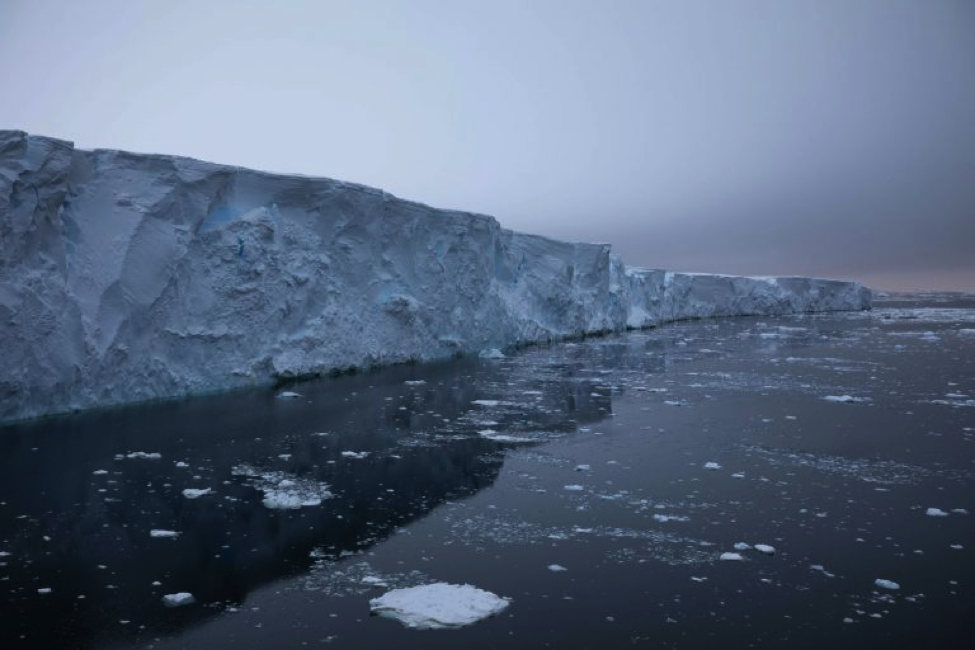
The front face of the Thwaites Glacier extends 18 – 23 metres above sea level. Photo: Carolyn Beeler/The World.
Stretching over an expanse of Antarctica almost the size of Great Britain is a vast sheet of ice called the Thwaites, aptly nicknamed the Doomsday Glacier.
As the earth warms at an accelerating rate, triggered by the heat-trapping effects of greenhouse gases, the Thwaites Glacier is set to trigger a massive rise in global sea levels. Once it melts away, it threatens to submerge coastal cities and even large parts of countries.
Antarctica, holding about 90 per cent of the ice on the planet, is central to the future rise of sea levels. Formed as centuries of snowfall compacted into ice, its ice sheet can be as much as two kilometres thick. As the ice builds up, it is pushed outward to the edges of the continent as glaciers.
Antarctica’s Eastern ice sheet sits on high ground mainly above sea level, while its Western counterpart sits atop land that is mostly below sea level. It is here where ice is most compromised by warming waters, and it is here that the Thwaites Glacier rests.
This warm seawater originates in the North Atlantic and flows deep beneath a layer of colder water toward the South Atlantic. Shifting wind patterns due to a warming Pacific Ocean allow this warm, deep circumpolar water to well up over Antarctica’s continental shelf, encroaching on the icy continent.
The anatomy of the Thwaites Glacier itself reveals clues as to how quickly and how much of it will melt when faced with a warming climate.
While glaciers originate on land, the portion that tapers as it extends toward the sea sits on top of the water. This is a glacier’s ice shelf and it acts to buttress its main body.
As oceans and the atmosphere warm, these icy ramparts weaken, leading to increased melting and calving where the ice face crumbles away as icebergs. Crumbling ice shelves can no longer support the ice behind them, and glaciers become preconditioned for further disintegration. To make things worse, declining snowfall means glaciers can’t replenish themselves.
The Thwaites Glacier, falling victim to its own location and structure, already contributes four per cent to rising global sea levels as its ice flows into the Amundsen Sea - a huge figure for a single glacier. Owing to a collapsing ice shelf, glacial “earthquakes” have been detected on its surface for the first time.
Usually the ice that breaks off of glaciers is thinner and just drifts away, but the ice at the edge of the Thwaites is thick. With warm water melting it from underneath, icebergs taller than they are wide are released, capsizing and colliding with the front edge of the glacier as they turn.
While this glacial disintegration is visible and dramatic, what lies below the water’s surface betrays another cause for concern.
The land beneath the Thwaites Glacier, the bedrock, slopes downward. The point at which the glacier meets the bedrock is called the grounding line, and as the ice of the glacier’s underside melts, the grounding line shifts back. Over time, more of the glacier sits directly above water instead of being attached to land, promoting accelerated melting from beneath.
What’s more is that cavities have now been detected below the glacier just ahead of its grounding line, further endangering its hold on the ground, allowing for warm water to impose deeper on the underside. Warm water has recently been measured for the first time at the grounding line. The temperature and high turbulence of this water allows it to more efficiently melt the base. One cavity in particular clocks in at two thirds the size of Manhattan.
That isn’t all. Glacial ice, built of fallen snow, is fresh water, making it light relative to salty seawater. As glaciers melt, the light, fresh water flows upwards towards the glacier and heavier, warmer sea water is drawn up behind it. When sea water is cold this process occurs slowly, melting just a few dozen centimeters of the glacier a year, an amount easily balanced by new ice created by falling slow. Warm sea water, on the other hand, can increase melting rates a hundred-fold.
Should the Thwaites Glacier collapse, sea levels could rise by half a meter, but the harm doesn’t end there. Since the glacier stretches into the centre of Antarctica’s western edge, its crumbling could destabilize the rest of the western ice sheet, kicking off a multi-glacier collapse and resulting in more than three metres of sea level rise over the next few centuries. That’s enough to submerge parts of London, Vancouver, and New York City.
Scientists still debate how imminent Thwaites’ full collapse is. While it is predicted it will take centuries, some believe the process has already begun. What scientists do know for certain is that once it gives way, there is no stopping it. Collapse, once begun, is inevitable.
Human action to curb greenhouse gases will alone determine how much ice is lost and how quickly. If we squander the opportunity to be proactive, the planet’s coasts as we know them, together with some of the world’s greatest cities, are inevitably imperiled.
References:
By: Natalie Workewych
Natalie is a PhD Student studying Pharmacology at the University of Toronto. Her academic background includes an undergraduate degree in Biochemistry and Pharmacology. She hopes to encourage ideas through writing, and bring thoughts on science to anyone the least bit curious.
